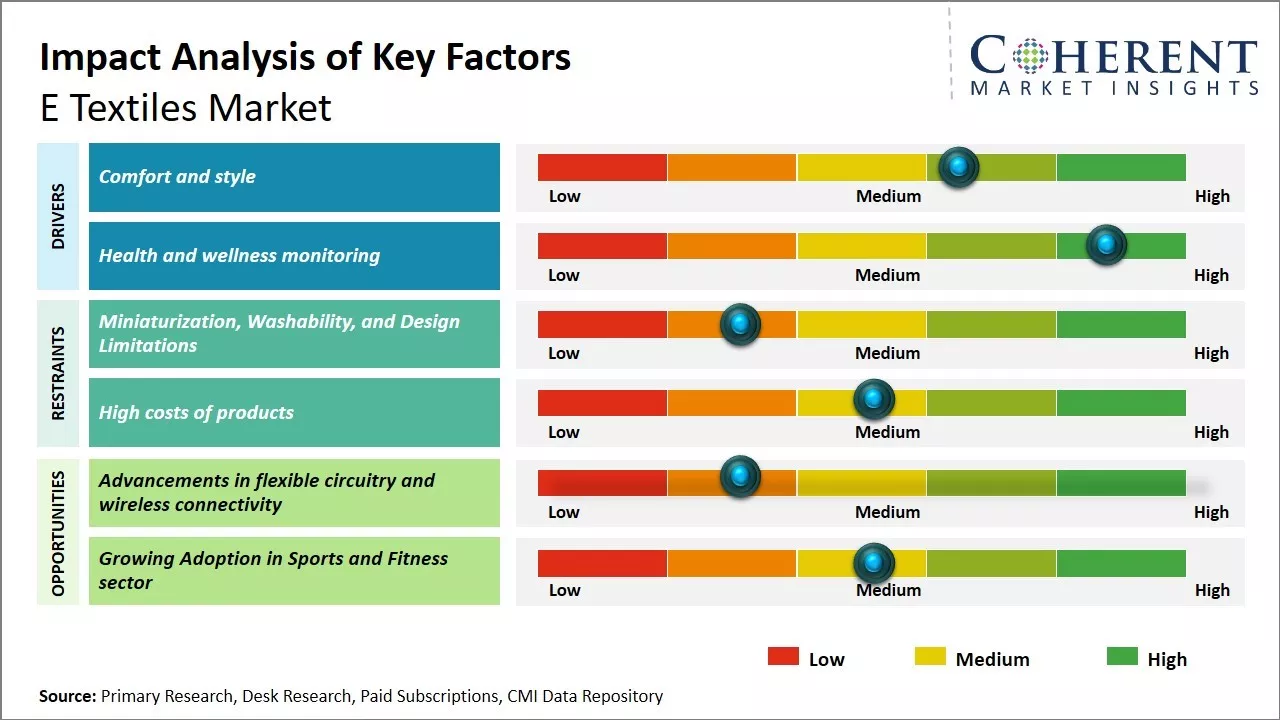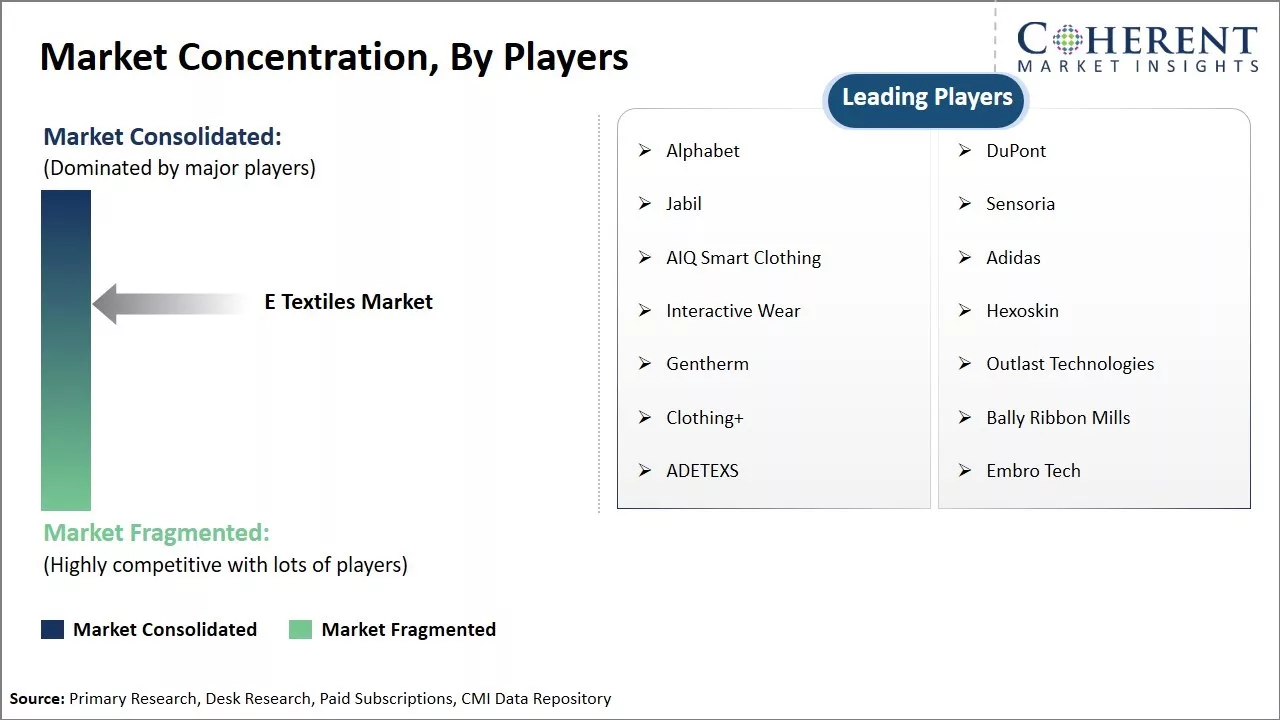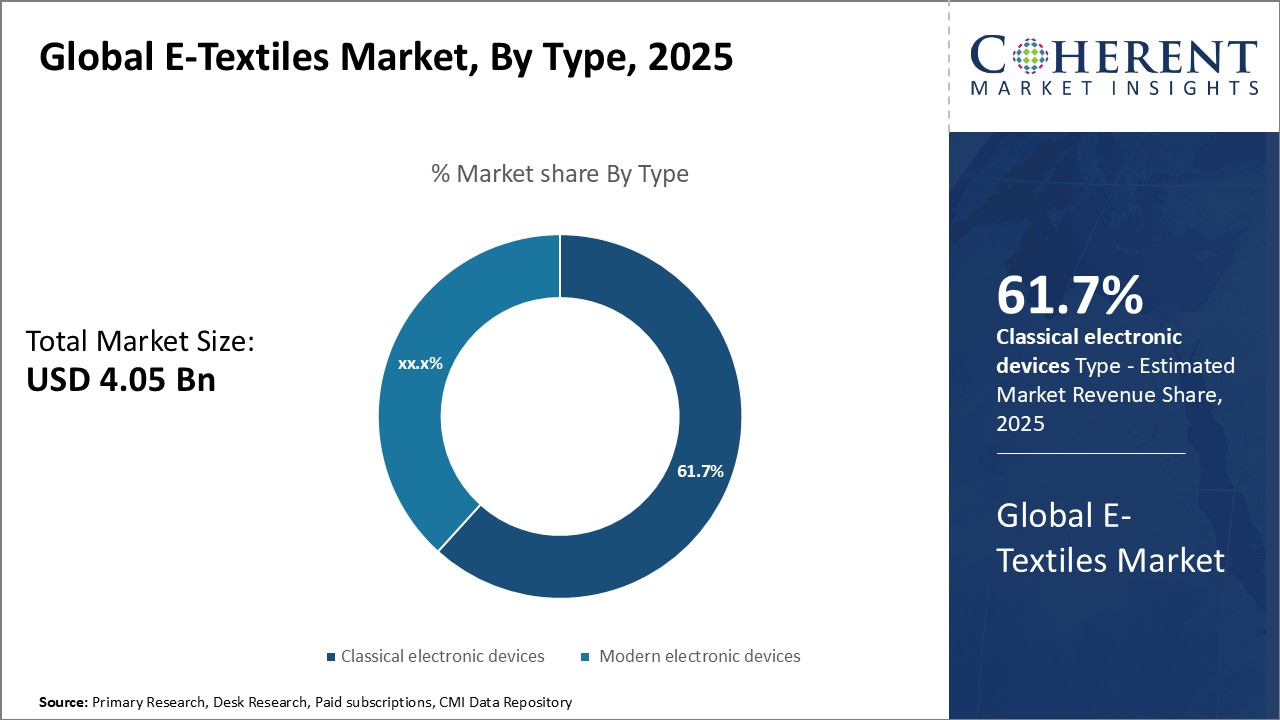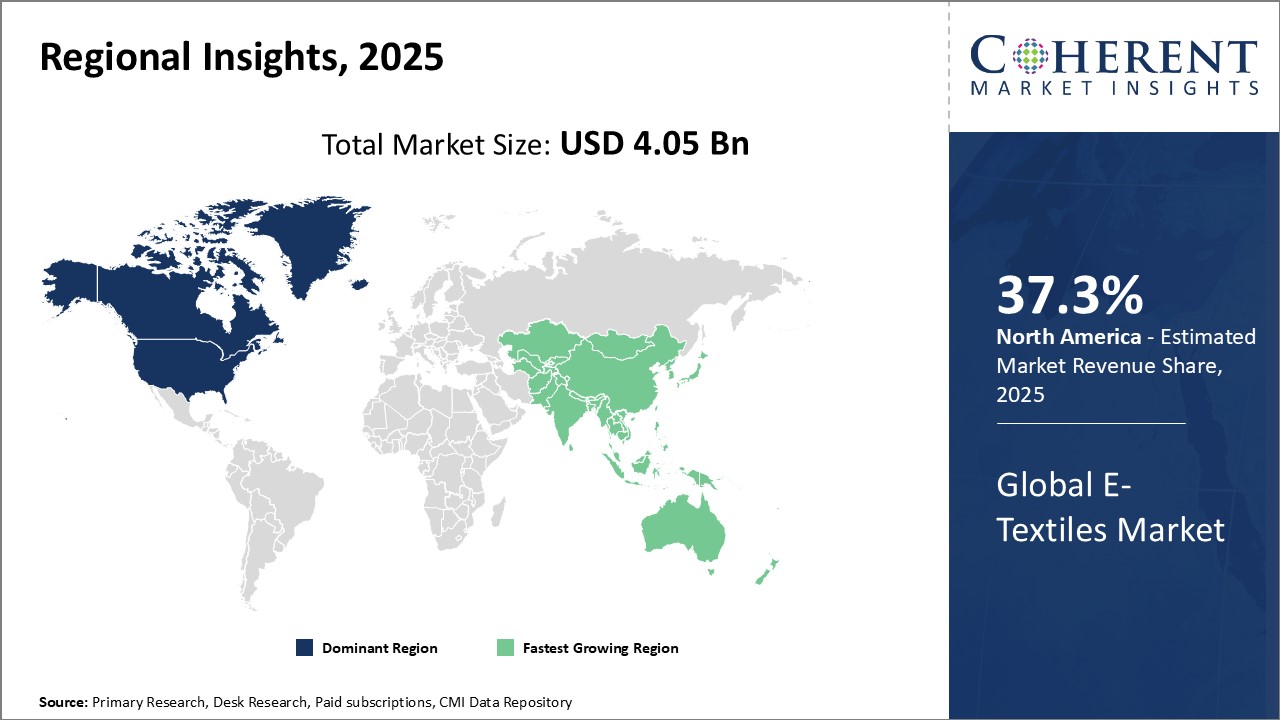Global E-Textiles Market Size and Trends
Global E-textiles market is estimated to be valued at USD 4.05 Bn in 2025 and is expected to reach USD 7.08 Bn by 2032, exhibiting a compound annual growth rate (CAGR) of 8.3% from 2025 to 2032.

Discover market dynamics shaping the industry: Download Free Sample
The market growth is driven by increasing demand for smart fabrics that integrate advanced technologies. Applications across the healthcare, military and defense sectors boosts significant investment in the research and development of new e-textile products. Global E-textiles market is expected to witness considerable growth over the forecast period. Traditional textiles are increasingly being incorporated with electronics and advanced materials to create smarter and more functional fabrics. Manufacturers are developing sophisticated e-textiles for applications such as patient monitoring suits, military uniforms with sensors and performance sportswear. The integration of low-cost flexible electronics, miniaturized components and nanotechnology will continue to expand the potential uses of e-textiles.
Comfort and style
Rising demand for comfortable and fashionable clothes is expected to drive the global E-textiles market growth. Consumers are looking for fabrics that not only look good but also feel soft and breathable against the skin. E-textiles address this need directly by integrating various functionalities into garments without compromising on aesthetics or comfort. The electrically conductive threads, fibers and yarns blended into textiles allow them to actively monitor the wearer's vitals, regulate temperature as per the surroundings, and light up for visibility in low light conditions, all without adding any noticeable weight, bulk or stiffness to the cloth. This has made e-textiles increasingly popular for daily as well as athletic wear. Sports brands are particularly drawing consumers through e-apparels enhanced with features like heartbeat monitoring, hydration level sensing, GPS tracking and fall detection. Consumers find such smart add-ons extremely useful for optimized performance and safety during workouts without giving up the breathable, flexible feel of regular clothes.
Market Concentration and Competitive Landscape

Get actionable strategies to beat competition: Download Free Sample
Health and wellness monitoringThe global e-textiles market is experiencing tremendous growth driven by the increasing focus on health and wellness monitoring applications. Wearable technologies integrated with smart textiles are enabling constant health monitoring in a non-invasive manner. Various e-textile brands are incorporating advanced sensors that can track vital statistics like heart rate, respiration, blood oxygen levels, ECG, and sleep patterns. This provides valuable health insights to users and also helps detect potential health issues at an early stage. The COVID-19 pandemic has further accelerated the demand for such remote health monitoring solutions. Many hospitals and Governments across the world are actively deploying e-textile powered wearables to enable contactless remote patient monitoring of COVID infected individuals in home isolation. For example, the Indian Government initiated a pilot project in 2021 involving distribution of around 500 smart garments and fabrics to COVID patients that can transmit health data like temperature, pulse rate to registered medical professionals (Press Trust of India, 2021). This helps optimize utilization of precious medical resources and infrastructure while allowing early intervention if critical parameters are detected. Going forward, the integration of e-textiles with advanced technologies like AI and cloud computing is expected to further expand their health monitoring capabilities. Clothing embedded with miniaturized flexible sensors, computers and advanced algorithms will be able to conduct detailed health screening and predict potential illnesses even before clinical symptoms arise. This will significantly boost preventive healthcare and lower long term medical costs. The growing preference for healthier lifestyles and increasing elderly population prone to chronic conditions also makes the e-textiles market well-positioneda achieve sustainable growth over the next decade.

To learn more about this report, Download Free Sample
Market Challenges: Miniaturization, Washability, and Design LimitationsGlobal e-textiles market still faces several technological challenges. Sensors and electronic components able to be embedded in fabrics remain bulky, limiting design options and consumer appeal. Washability also poses an issue, as electronics need to withstand numerous cleaning cycles without degrading. Further miniaturization of components and development of durable conductive fabrics are still needed to help the industry mature.
Market Opportunities: Advancements in flexible circuitry and wireless connectivity
Advancements in flexible circuitry and wireless connectivity create lucrative opportunities. As fibers and elastic materials mimic the properties of regular clothes, e-textiles gain wider acceptance. Applications in health monitoring, entertainment, and smart home integration open new revenue streams. Partnerships between apparel and tech firms aiming to create versatile, fashionable garments will drive innovation. The convergence of wearables and fabric computing has bright commercial potential.

Discover high revenue pocket segments and roadmap to it: Download Free Sample
Insights, By Type: Driven by New Applications and Connected Lifestyle TrendsIn terms of type, modern electronic devices segment is estimated to contribute the 61.7% share of the market in 2025, owing to growing consumer demand for smarter and more connected textiles integrated with cutting edge technologies. Modern electronic devices include smart garments, smartphone integrated apparel, wearable displays and digital skins that have expanded the commercial scope of e-textiles. The current generation of consumers, especially millennials and Gen Z, are the early adopters of such modern wearable innovations due to their active lifestyle and appetite for new experiences. These represent a lucrative demographic for apparel brands focusing on wellness, entertainment and self-expression through e-textiles. Further, rapid developments in miniaturized electronics, low-power capacitive fabrics, OLEDs and flexible displays have enabled new form factors and functionalities. This has supported innovative product concepts around smart home decor, self-health monitoring skins and interactive multiplayer gaming suits. Several major apparel retailers have also partnered with startups to introduce affordable smart clothing lines targeting casual users.
Insights, By Application: Growing Demands for Combat Uniforms
In terms of applications, defense segment is estimated to contribute the 43.2% share of the E-textiles market, owing to growing demand for combat uniforms integrated with advanced C4ISR capabilities. Modern battlefields pose new threats that require new solutions beyond traditional cotton fatigues. Militaries worldwide are investing in developing smart camouflage, soldier safety systems, and physiological status monitoring and heads-up sensors woven into fabric. These smart garments leverage technologies such as infrared cameras, biometric sensors, GPS trackers and ballistic armor to provide soldiers a tactical advantage. Rising geo-political tensions have also prompted defense budgets to incorporate innovative textile-based technologies for surveillance, communication and lifesaving. National defense agencies regularly solicit proposals from domestic e-textile firms to design uniforms with integrated interactive camouflage, embedded health analytics and intelligent ammunition counters. International defense cooperatives also collaborate on advancing wearable CBRN detection fabrics and power-generating uniforms for future soldiers. As unconventional warfare evolves rapidly, e-textiles will remain critical for the defense segment to gain real-time battlefield visibility and protect combatants.
Regional Insights

Need a Different Region or Segment? Download Free Sample
North America has dominated the global E-textiles market for many years owing to substantial investments in research and development by major players located in the region with estimated 37.3% market share in 2025. Countries like the U.S. and Canada have witnessed tremendous growth in wearable technology adoption in sectors such as healthcare, sports, and defense.
One of the fastest growing regions for e-textiles is Asia Pacific due to rising export focus of China and South Korea. China especially has emerged as a global hub for textile and apparel manufacturing over the past decade. These now have a skilled workforce and established supply chain infrastructure to support the growing needs of e-textiles. This allows China to quickly scale up production and meet large export orders from major technology brands. These also have a relatively low cost of manufacturing compared to developed markets. South Korea is home to Samsung and LG who are investing heavily in next-generation display technologies like OLED that can be integrated into fabrics. This has provided an impetus for the development of advanced e-textiles in Asia Pacific.
Market Report Scope
Global E-Textiles Market Report Coverage
| Report Coverage | Details | ||
|---|---|---|---|
| Base Year: | 2024 | Market Size in 2025: | USD 4.05 Bn |
| Historical Data for: | 2020 To 2024 | Forecast Period: | 2025 To 2032 |
| Forecast Period 2025 to 2032 CAGR: | 8.3% | 2032 Value Projection: | USD 7.08 Bn |
| Geographies covered: |
|
||
| Segments covered: |
|
||
| Companies covered: |
Alphabet, DuPont, Jabil, Sensoria, AIQ Smart Clothing, Adidas, Interactive Wear, Hexoskin, Gentherm, Outlast Technologies, Clothing+, Bally Ribbon Mills, ADETEXS, Embro Tech |
||
| Growth Drivers: |
|
||
| Restraints & Challenges: |
|
||
Uncover macros and micros vetted on 75+ parameters: Get instant access to report
Global E-Textiles Industry News
- In February 2024, Bharat Tex 2024, one of the largest-ever global textile events, was organized in the country. The event has a unified farm to foreign via fibre, fabric and fashion focus, covering the entire textile value chain.
- In 2022, Textile Exchange and TextileGenesisTM announced the pilot release of Textile Exchange’s Electronic Trackit “eTrackit” program
*Definition: Global E-Textiles Market refers to growing industry of developing electronic functionalities into regular fabrics and textiles. Products in this market integrate advanced electronic and digital technologies into clothing, accessories, and home goods to enable additional capabilities like lighting effects, fitness/health tracking, communication abilities, and more. E-textiles are revolutionizing traditional fabrics by enriching them with smart and interactive qualities for numerous applications.
Market Segmentation
- Type Insights (Revenue, USD Bn, 2020 - 2032)
- Classical electronic devices
- Modern electronic devices
- Applications Insights (Revenue, USD Bn, 2020 - 2032)
- Sports & Fitness
- Defense
- Protection & Military
- Healthcare
- Household Textiles
- Fashion & Entertainment
- Others
- Regional Insights (Revenue, USD Bn, 2020 - 2032)
- North America
- U.S.
- Canada
- Latin America
- Brazil
- Argentina
- Mexico
- Rest of Latin America
- Europe
- Germany
- U.K.
- Spain
- France
- Italy
- Russia
- Rest of Europe
- Asia Pacific
- China
- India
- Japan
- Australia
- South Korea
- ASEAN
- Rest of Asia Pacific
- Middle East & Africa
- GCC Countries
- Israel
- Rest of Middle East & Africa
- North America
- Key Players Insights
- Alphabet
- DuPont
- Jabil
- Sensoria
- AIQ Smart Clothing
- Adidas
- Interactive Wear
- Hexoskin
- Gentherm
- Outlast Technologies
- Clothing+
- Bally Ribbon Mills
- ADETEXS
- Embro Tech
Share
Share
About Author
Vidyesh Swar is a seasoned Consultant with a diverse background in market research and business consulting. With over 6 years of experience, Vidyesh has established a strong reputation for his proficiency in market estimations, supplier landscape analysis, and market share assessments for tailored research solution. Using his deep industry knowledge and analytical skills, he provides valuable insights and strategic recommendations, enabling clients to make informed decisions and navigate complex business landscapes.
Missing comfort of reading report in your local language? Find your preferred language :
Transform your Strategy with Exclusive Trending Reports :
Frequently Asked Questions
EXISTING CLIENTELE
Joining thousands of companies around the world committed to making the Excellent Business Solutions.
View All Our Clients
